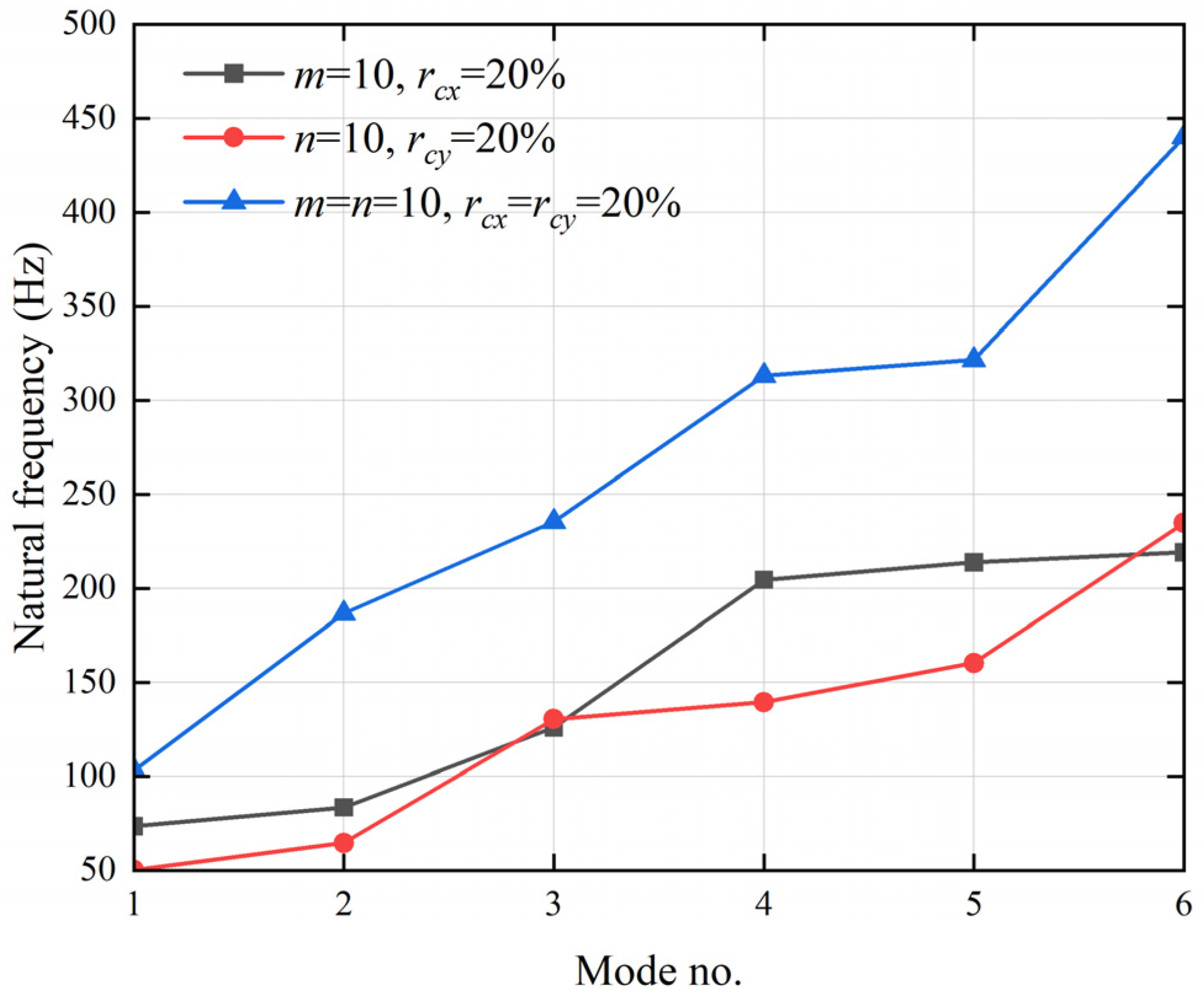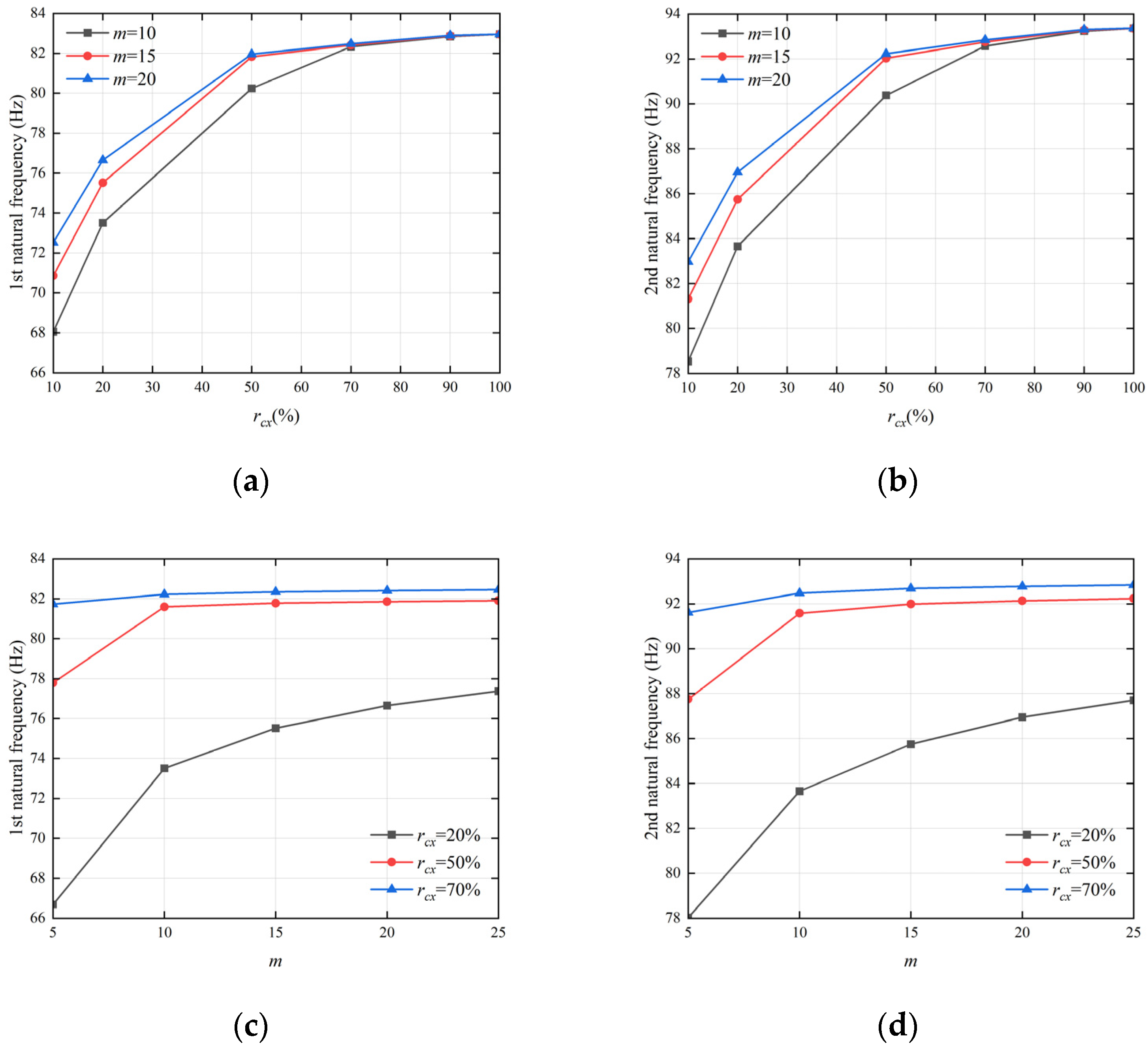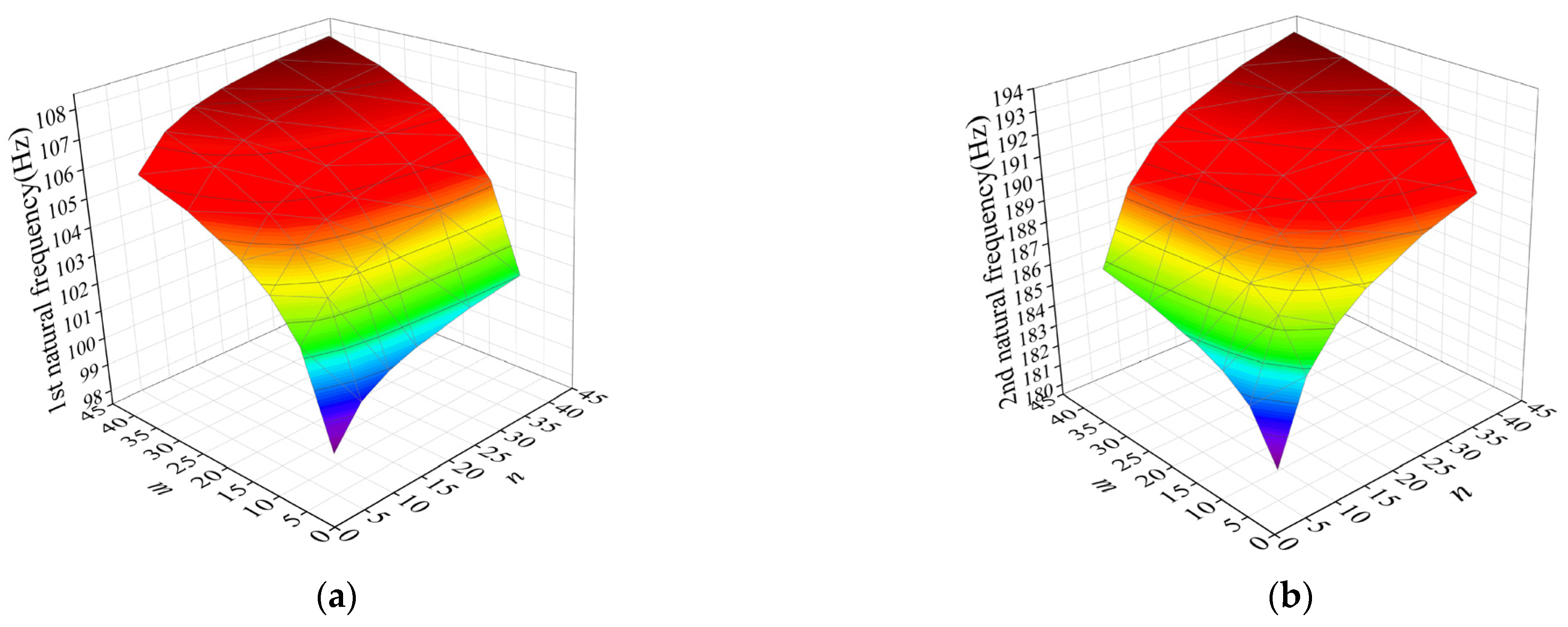Dynamic Modeling and Analysis of Boundary Effects in Vibration Modes of Rectangular Plates with Periodic Boundary Constraints Based on the Variational Principle of Mixed Variables
Abstract
:1. Introduction
2. Theoretical Formula
2.1. Description of the Model
2.2. Energy Expressions
2.3. Solution to Free Vibration
3. Results and Discussion
3.1. Model Validation
3.2. Parametric Study
3.2.1. Effects of the Form of Boundary Period Distribution on the Natural Frequencies of Thin Rectangular Plates
3.2.2. Effects of the Number of Periods and the Ratio of Clamping Support on the Natural Frequency of Thin Rectangular Plates
3.2.3. Effects of Combined Boundary Conditions on the Natural Frequencies of the Thin Rectangular Plate
4. Conclusions
- A new dynamic modeling method for periodically bounded rectangular plates based on the variational principle of mixed variables is proposed. In particular, the proposed boundary constraint equivalence method based on the energy equivalence principle realizes the transformation of the periodic constraint boundary from “structural geometric constraint” to “mathematical physical constraint”, and this method provides a theoretical basis for the design of periodic boundaries of plate structures and the control of vibration noise of plates.
- The influence law of the periodic boundary constraint form of the rectangular plate on the modal frequency of the plate structure is revealed, which provides a theoretical basis for adjusting the modal frequency and improving its dynamic characteristics through the design of the boundary constraint conditions. The plate stiffness and modal properties can be changed by introducing periodic boundaries to change the additional energy of the plate boundary. Any combination of periodic, free, and simply supported boundaries can adjust the modal frequency of the rectangular plate in a wider range, which is more conducive to avoid resonance and reduce the vibration noise of the structure.
- The influence law of the period-constrained boundary parameters on the dynamic properties of rectangular plates is revealed. In this paper, the relationship between the number of periods, clamped support ratio, and modal frequency of the boundary periodically constrained rectangular plate shows that the clamped support ratio has more significant influence on the inherent characteristics of the plate structure compared to the number of periods. For the traditional bolted rectangular plate, the design of the clamp support ratio and number of periods can be used to regulate the dynamic properties of the plate.
Author Contributions
Funding
Data Availability Statement
Conflicts of Interest
Appendix A
References
- Guo, W.; Li, T.; Zhu, X.; Miao, Y. Sound-structure interaction analysis of an infinite-long cylindrical shell submerged in a quarter water domain and subject to a line-distributed harmonic excitation. J. Sound Vib. 2018, 422, 48–61. [Google Scholar] [CrossRef]
- Lin, H.; Liu, H.; Wei, P. A parallel parameterized level set topology optimization framework for large-scale structures with unstructured meshes. Comput. Methods Appl. Mech. Eng. 2022, 397, 115112. [Google Scholar] [CrossRef]
- Obradovic, A.; Salinic, S.; Grbovic, A. Mass minimization of an Euler-Bernoulli beam with coupled bending and axial vibrations at prescribed fundamental frequency. Eng. Struct. 2020, 228, 111538. [Google Scholar] [CrossRef]
- Hong, Z.; Hu, X.; Fang, T. Analytical solution to steady-state temperature field of Freeze-Sealing Pipe Roof applied to Gongbei tunnel considering operation of limiting tubes. Tunn. Undergr. Space Technol. 2020, 105, 103571. [Google Scholar] [CrossRef]
- Rafiei, B.; Masoumi, H.; Aghighi, M.S.; Ammar, A. Effects of complex boundary conditions on natural convection of a viscoplastic fluid. Int. J. Numer. Methods Heat Fluid Flow 2019, 29, 2792–2808. [Google Scholar] [CrossRef]
- Baddoo, P.J.; Ayton, L.J. Acoustic scattering by cascades with complex boundary conditions: Compliance, porosity and impedance. J. Fluid Mech. 2020, 898, A16. [Google Scholar] [CrossRef]
- Xing, Z.; Wang, X.; Zhao, W.; Wang, F. Calculation of Stator Natural Frequencies of Electrical Machines Considering Complex Boundary Conditions. IEEE Trans. Ind. Appl. 2022, 58, 7079–7087. [Google Scholar] [CrossRef]
- Liu, M.; Wang, Z.; Zhou, Z.; Qu, Y.; Yu, Z.; Wei, Q.; Lu, L. Vibration response of multi-span fluid-conveying pipe with multiple accessories under complex boundary conditions. Eur. J. Mech.—A/Solids 2018, 72, 41–56. [Google Scholar] [CrossRef]
- Xin, Y.; Zhou, Z.; Li, M.; Zhuang, C. Analytical Solutions for Unsteady Groundwater Flow in an Unconfined Aquifer under Complex Boundary Conditions. Multidiscip. Digit. Publ. Inst. 2019, 12, 75. [Google Scholar] [CrossRef]
- Zhang, J.; Li, T.; Zhu, X. Free Vibration Analysis of Rectangular Fgm Plates with a Cutout. IOP Conf. Ser. Earth Environ. Sci. 2019, 283, 012037. [Google Scholar] [CrossRef]
- Van Minh, P.; Van Ke, T. A Comprehensive Study on Mechanical Responses of Non-uniform Thickness Piezoelectric Nanoplates Taking into Account the Flexoelectric Effect. Arab. J. Sci. Eng. 2022, 1–26. [Google Scholar] [CrossRef]
- Guinchard, M.; Angeletti, M.; Boyer, F.; Catinaccio, A.; Gargiulo, C.; Lacny, L.; Laudi, E.; Scislo, L. Experimental modal analysis of lightweight structures used in particle detectors: Optical non-contact method. In Proceedings of the 9th International Particle Accelerator Conference, IPAC18, Vancouver, BC, Canada, 28 April–4 May 2018; pp. 2565–2567. [Google Scholar]
- Price, S.M. A comparison of Operating Deflection Shape and Motion Amplification Video Techniques for Vibration Analysis. In Proceedings of the Asia Turbomachinery & Pump Symposium 2022, Kuala Lumpur, Malaysia, 24–26 May 2022. [Google Scholar]
- Chen, J.G.; Wadhwa, N.; Cha, Y.J.; Durand, F.; Freeman, W.T.; Buyukozturk, O. Structural modal identification through high speed camera video: Motion magnification. In Topics in Modal Analysis I, Volume 7, Proceedings of the 32nd IMAC, A Conference and Exposition on Structural Dynamics, 2014; Springer International Publishing: Berlin/Heidelberg, Germany, 2014; pp. 191–197. [Google Scholar]
- Zhao, X. Analytical solution of deflection of multi-cracked beams on elastic foundations under arbitrary boundary conditions using a diffused stiffness reduction crack model. Arch. Appl. Mech. 2021, 91, 277–299. [Google Scholar] [CrossRef]
- Zhou, Z.; Huang, X.; Hua, H. Large amplitude vibration analysis of a non-uniform beam under arbitrary boundary conditions based on a constrained variational modeling method. Acta Mech. 2021, 232, 4811–4832. [Google Scholar] [CrossRef]
- Peng, X.; Xu, J.; Yang, E.; Li, Y.; Yang, J. Influence of the boundary relaxation on free vibration of functionally graded carbon nanotube-reinforced composite beams with geometric imperfections. Acta Mech. 2022, 233, 4161–4177. [Google Scholar] [CrossRef]
- Han, H.; Cao, D.; Liu, L.; Gao, J.; Li, Y. Free vibration analysis of rotating composite Timoshenko beams with bending-torsion couplings. Meccanica 2021, 56, 1191–1208. [Google Scholar] [CrossRef]
- Pham, Q.H.; Tran, V.K.; Nguyen, P.C. Hygro-thermal vibration of bidirectional functionally graded porous curved beams on variable elastic foundation using generalized finite element method. Case Stud. Therm. Eng. 2022, 40, 102478. [Google Scholar] [CrossRef]
- Xue, Z.; Li, Q.; Huang, W.; Wang, J. Vibration Characteristics Analysis of Moderately Thick Laminated Composite Plates with Arbitrary Boundary Conditions. Materials 2019, 12, 2829. [Google Scholar] [CrossRef] [PubMed]
- Hu, Z.; Zhou, K.; Chen, Y. Sound Radiation Analysis of Functionally Graded Porous Plates with Arbitrary Boundary Conditions and Resting on Elastic Foundation. Int. J. Struct. Stab. Dyn. 2020, 20, 1291–1299. [Google Scholar] [CrossRef]
- Cui, J.; Li, Z.; Ye, R.; Jiang, W.; Tao, S. A Semianalytical Three-Dimensional Elasticity Solution for Vibrations of Orthotropic Plates with Arbitrary Boundary Conditions. Shock. Vib. 2019, 2019, 1237674. [Google Scholar] [CrossRef]
- Xue, Z.C.; Li, Q.H.; Wang, J.F.; Lan, Z.X. Vibration analysis of fiber reinforced composite laminated plates with arbitrary boundary conditions. In Key Engineering Materials; Trans. Tech. Publications Ltd.: Stafa-Zurich, Switzerland, 2019; Volume 818, pp. 104–112. [Google Scholar]
- Xiao, J.; Wang, J. Variational analysis of laminated nanoplates for various boundary conditions. Acta Mech. 2022, 233, 4711–4728. [Google Scholar] [CrossRef]
- Hui, L.; Dla, B.; Pla, B.; Zhao, J.; Han, Q.; Wang, Q. A unified vibration modeling and dynamic analysis of FRP-FGPGP cylindrical shells under arbitrary boundary conditions. Appl. Math. Model. 2021, 97, 69–80. [Google Scholar]
- Dehrouyeh-Semnani, A.M.; Mostafaei, H. Vibration analysis of scale-dependent thin shallow microshells with arbitrary planform and boundary conditions. Int. J. Eng. Sci. 2021, 158, 103413. [Google Scholar] [CrossRef]
- Liu, Y.; Zhu, R.; Qin, Z.; Chu, F. A comprehensive study on vibration characteristics of corrugated cylindrical shells with arbitrary boundary conditions. Eng. Struct. 2022, 269, 114818. [Google Scholar] [CrossRef]
- Fu, T.; Wu, X.; Xiao, Z.; Chen, Z. Study on dynamic instability characteristics of functionally graded material sandwich conical shells with arbitrary boundary conditions. Mech. Syst. Signal Process. 2021, 151, 107438. [Google Scholar] [CrossRef]
- Zhang, Z.; Gu, J.; Ding, J.; Tao, Y. A Semianalytic Method for Vibration Analysis of a Sandwich FGP Doubly Curved Shell with Arbitrary Boundary Conditions. Shock. Vib. 2021, 2021, 9704123. [Google Scholar] [CrossRef]
- Li, C.; Li, P.; Miao, X. Research on nonlinear vibration control of laminated cylindrical shells with discontinuous piezoelectric layer. Nonlinear Dyn. 2021, 104, 3247–3267. [Google Scholar] [CrossRef]
- Han, P.; Ri, K.; Choe, K.; Han, Y. Vibration analysis of rotating cross-ply laminated cylindrical, conical and spherical shells by using weak-form differential quadrature method. J. Braz. Soc. Mech. Sci. Eng. 2020, 42, 352. [Google Scholar] [CrossRef]
- Li, C. Free vibration analysis of a rotating varying-thickness-twisted blade with arbitrary boundary conditions. J. Sound Vib. 2021, 492, 115791. [Google Scholar] [CrossRef]
- Uzun, B.; Kafkas, U.; Yaylı, M.Ö. Axial dynamic analysis of a Bishop nanorod with arbitrary boundary conditions. ZAMM-J. Appl. Math. Mech./Z. Für Angew. Math. Und Mech. 2020, 100, e202000039. [Google Scholar] [CrossRef]
- Zhong, T.; Yang, C. Application of the patch transfer function method for predicting flow-induced cavity oscillations. J. Sound Vib. 2022, 521, 116678. [Google Scholar] [CrossRef]
- Kiarasi, F.; Babaei, M.; Asemi, K.; Dimitri, R.; Tornabene, F. Three-dimensional buckling analysis of functionally graded saturated porous rectangular plates under combined loading conditions. Appl. Sci. 2021, 11, 10434. [Google Scholar] [CrossRef]
- Kiarasi, F.; Babaei, M.; Dimitri, R.; Tornabene, F. Hygrothermal modeling of the buckling behavior of sandwich plates with nanocomposite face sheets resting on a Pasternak foundation. Contin. Mech. Thermodyn. 2021, 33, 911–932. [Google Scholar] [CrossRef]
- Amabili, M. Nonlinear vibrations of rectangular plates with different boundary conditions: Theory and experiments. Comput. Struct. 2004, 82, 2587–2605. [Google Scholar] [CrossRef]
- Ducceschi, M. Nonlinear Vibrations of Thin Rectangular Plates: A Numerical Investigation with Application to Wave Turbulence and Sound Synthesis. Ph.D. Thesis, ENSTA ParisTech, Palaiseau, France, 2014. [Google Scholar]
- Mohd Zin, M.S.; Abdul Rani, M.N.; Yunus, M.A.; Wan Iskandar Mirza WI, I.; Mat Isa, A.A.; Mohamed, Z. Modal and FRF based updating methods for the investigation of the dynamic behaviour of a plate. J. Mech. Eng. (JMechE) 2017, 3, 175–189. [Google Scholar]
- Su, J.; Zhou, K.; Qu, Y.; Hua, H. A variational formulation for vibration analysis of curved beams with arbitrary eccentric concentrated elements. Arch. Appl. Mech. 2018, 88, 1089–1104. [Google Scholar] [CrossRef]
- Su, J.; He, W.; Zhang, K.; Hua, H. Vibration analysis of functionally graded porous cylindrical shells filled with dense fluid using an energy method. Appl. Math. Model. 2022, 108, 167–188. [Google Scholar] [CrossRef]
- Fu, B. Variational Principles with Mixed Variables in Elasticity and Their Applications; National Defense Industry Press: Beijing, China, 2010. (In Chinese) [Google Scholar]







| Property | Al |
|---|---|
| Pattern | ||||||||
|---|---|---|---|---|---|---|---|---|
| BC1 | 10 | 10 | 6/54 | 6/44 | 48/54 | 38/54 | 0 | 0 |
| BC2 | 30 | 10 | 6/18 | 6/44 | 12/18 | 38/54 | 0 | 0 |
| BC3 | 30 | 10 | 6/18 | 8/44 | 12/18 | 36/54 | 0 | 0 |
| BC | Modal Order | Theoretical Results (Hz) | Experiment Results (Hz) | Error |
|---|---|---|---|---|
| BC1 | 1 | 129.85 | 130.00 | 0.12% |
| 2 | 229.46 | 229.00 | 0.20% | |
| 3 | 295.92 | 295.00 | 0.31% | |
| 4 | 387.23 | 384.00 | 0.84% | |
| 5 | 540.11 | 542.00 | 0.35% | |
| BC2 | 1 | 133.18 | 129.58 | 2.78% |
| 2 | 232.20 | 224.55 | 3.41% | |
| 3 | 305.99 | 297.85 | 2.73% | |
| 4 | 392.9 | 389.18 | 0.96% | |
| 5 | 549.26 | 553.13 | 0.70% | |
| BC3 | 1 | 133.34 | 132.56 | 0.59% |
| 2 | 232.78 | 229.42 | 1.46% | |
| 3 | 306.09 | 301.57 | 1.50% | |
| 4 | 394.08 | 389.99 | 1.05% | |
| 5 | 550.36 | 555.84 | 0.99% |
Disclaimer/Publisher’s Note: The statements, opinions and data contained in all publications are solely those of the individual author(s) and contributor(s) and not of MDPI and/or the editor(s). MDPI and/or the editor(s) disclaim responsibility for any injury to people or property resulting from any ideas, methods, instructions or products referred to in the content. |
© 2023 by the authors. Licensee MDPI, Basel, Switzerland. This article is an open access article distributed under the terms and conditions of the Creative Commons Attribution (CC BY) license (https://creativecommons.org/licenses/by/4.0/).
Share and Cite
Shi, Y.; Huang, Q.; Peng, J. Dynamic Modeling and Analysis of Boundary Effects in Vibration Modes of Rectangular Plates with Periodic Boundary Constraints Based on the Variational Principle of Mixed Variables. Mathematics 2023, 11, 2381. https://doi.org/10.3390/math11102381
Shi Y, Huang Q, Peng J. Dynamic Modeling and Analysis of Boundary Effects in Vibration Modes of Rectangular Plates with Periodic Boundary Constraints Based on the Variational Principle of Mixed Variables. Mathematics. 2023; 11(10):2381. https://doi.org/10.3390/math11102381
Chicago/Turabian StyleShi, Yuanyuan, Qibai Huang, and Jiangying Peng. 2023. "Dynamic Modeling and Analysis of Boundary Effects in Vibration Modes of Rectangular Plates with Periodic Boundary Constraints Based on the Variational Principle of Mixed Variables" Mathematics 11, no. 10: 2381. https://doi.org/10.3390/math11102381




